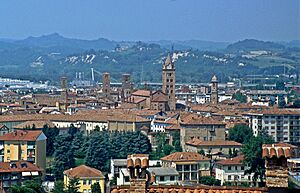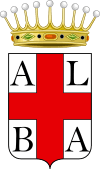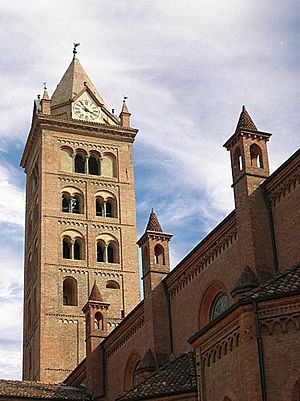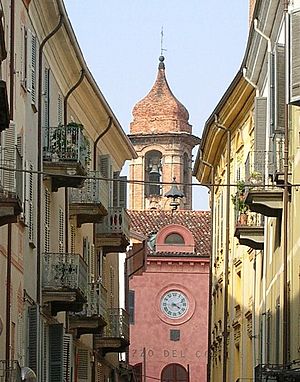Alba, Piedmont facts for kids
Quick facts for kids
Alba
Arba (Piedmontese)
|
||
|---|---|---|
| Comune di Alba | ||

View of the city of Alba
|
||
|
||
| Country | Italy | |
| Region | Piedmont | |
| Province | Cuneo (CN) | |
| Frazioni | Belmonte, Biglini, Camairana, Gallo, Ghiglini, Luisetto, Magliano, Mussotto, Prandi II, Ricca-San Rocco Cherasca, Rubbo, San Rocco Seno D'Elvio, Scaparone | |
| Area | ||
| • Total | 53.59 km2 (20.69 sq mi) | |
| Elevation | 172 m (564 ft) | |
| Population
(1 January 2021)
|
||
| • Total | 31,215 | |
| • Density | 582.48/km2 (1,508.61/sq mi) | |
| Demonym(s) | Albese(i) | |
| Time zone | UTC+1 (CET) | |
| • Summer (DST) | UTC+2 (CEST) | |
| Postal code |
12051
|
|
| Dialing code | 173 | |
| Patron saint | St. Lawrence | |
| Saint day | 10 August | |
Alba is a charming town in Piedmont, Italy. It's located in the Province of Cuneo. Alba is super famous for two things: its amazing white truffles and delicious wine. It's also home to the well-known candy company, Ferrero.
This town is part of a special UNESCO World Heritage Site. This site is called the "Vineyard Landscape of Piedmont: Langhe-Roero and Monferrato." In 2017, Alba also joined the UNESCO Creative Cities Network.
Contents
Discovering Alba's Past
Alba has a very long history. It started even before the Romans arrived. The area was likely home to ancient Celtic and Ligurian tribes.
How Alba Became a Roman Town
The modern town of Alba sits where the ancient Roman city of Alba Pompeia once stood. A Roman leader named Gnaeus Pompeius Strabo officially recognized it as a town. This happened while he was building a road connecting Aquae Statiellae (today's Acqui Terme) to Augusta Taurinorum (today's Turin).
A famous person from Alba was Publius Helvius Pertinax. He was a Roman emperor for a short time in 193 AD.
Alba Through the Ages
After the Roman Empire fell, Alba faced many attacks. Different groups like the Ostrogoths, Byzantines, and Lombards raided the city.
In the 11th century, Alba became a free city-state. This meant it could govern itself. It even joined the Lombard League, a group of cities that worked together.
Over the centuries, many powerful families and countries fought over Alba. These included the Montferrat family, the Visconti of Milan, and the Gonzaga family. Later, France and Spain also battled for control. Finally, in 1631, Alba became part of Savoy.
During the Napoleonic Wars, Alba was briefly part of a French-controlled republic. It was then returned to the Kingdom of Sardinia in 1814.
Alba's Role in World War II
Alba showed great bravery during World War II. Its citizens were part of the Italian resistance movement. They fought against the Fascist government.
On October 10, 1944, brave fighters called partisans freed the town. They created their own government, known as the Republic of Alba. This republic lasted for a few weeks, staying independent from the Fascist Republic of Salò. The Fascists took it back on November 2, 1944. However, French troops finally liberated Alba on May 2, 1945. For its heroic actions, Alba received a Gold Medal for Military Valour.
Where is Alba?
Alba is about 50 kilometers (31 miles) from the cities of Turin and Cuneo. It's located on the right side of the Tanaro river. The weather here is usually drier than in areas north of the Po river.
Exploring Alba's Landmarks
Alba has many interesting old buildings and historical sites.
Ancient Roman Remains
You can still see parts of the ancient Roman city. There are remains of its fortified gate. You can also find pieces of old buildings with beautiful marble and mosaics.
Important Buildings and Churches
- Palazzo Comunale (13th century): This is the city hall. Inside, you can see a painting called Nativity from 1501 by Macrino d'Alba.
- City towers (14th and 15th centuries): Alba was once known as the "City with hundred towers." Many of these towers still stand today.
- Duomo of San Lorenzo (12th-century): This is Alba's main church. It was built in the Romanesque style. Over time, it was changed many times. The current look is from the 19th century. However, three original doorways and the crypt are still there. The church has a beautiful wood-carved choir from 1512.
- San Domenico (13th-14th centuries): This church is built in the Gothic style. It has a special entrance with three arches. You can also see old frescoes (wall paintings) inside.
- St John the Baptist (San Giovanni Battista): This church has a Baroque style. It holds two important paintings: a Madonna of the Graces (1377) by Barnaba da Modena and a Madonna with Saints (1508) by Macrino d'Alba.
- Santa Maria Maddalena (late-18th century): This is a small church. It was designed by Bernardo Antonio Vittone. It holds the remains of Blessed Margaret of Savoy.
You can also visit the Federico Eusebio Civic Museum of Archaeology and Natural Sciences. It's a great place to learn about the area's history and nature.
Alba's Economy and Famous Products
Alba has a strong economy. It's especially known for its agriculture and food industry.
Wine Production
Alba is a very important center for wine production. There are 290 wineries in the area. They grow grapes on about 700 hectares (1,730 acres) of land. They produce a lot of wine every year!
Alba's wines are some of the most famous in Italy. They include:
- DOC wines: Barbera, Dolcetto, Nebbiolo.
- DOCG wines: Barbaresco, Barolo, Moscato.
Other Industries
The city is home to the world-famous candy company, Ferrero. They make delicious chocolates and sweets. Other important companies include the publishing house Società San Paolo and the textile company Miroglio.
Alba also has Banca d'Alba, which is Italy's largest cooperative credit bank. The international food chain Eataly also has a presence here.
White Truffles
Alba is famous worldwide for its special white truffles. These rare and expensive mushrooms are a true delicacy. Every year, Alba hosts a big Truffle Festival. People come from all over the world to enjoy it!
Alba's Climate
Alba has a humid subtropical climate. This means it has warm winters and hot summers. In January, the average temperature is around 5°C (41°F). In summer, temperatures can reach 35°C (95°F).
Most of the rain falls during spring and autumn. In July and August, there is less rain. During November and December, Alba can sometimes have fog.
| Climate data for Alba | |||||||||||||
|---|---|---|---|---|---|---|---|---|---|---|---|---|---|
| Month | Jan | Feb | Mar | Apr | May | Jun | Jul | Aug | Sep | Oct | Nov | Dec | Year |
| Mean daily maximum °C (°F) | 5.2 (41.4) |
8.0 (46.4) |
13.6 (56.5) |
18.0 (64.4) |
22.8 (73.0) |
26.6 (79.9) |
28.8 (83.8) |
27.4 (81.3) |
23.6 (74.5) |
18.2 (64.8) |
11.8 (53.2) |
6.4 (43.5) |
17.5 (63.6) |
| Daily mean °C (°F) | 1.6 (34.9) |
3.6 (38.5) |
8.6 (47.5) |
12.9 (55.2) |
17.2 (63.0) |
21.3 (70.3) |
23.2 (73.8) |
22.1 (71.8) |
18.6 (65.5) |
13.5 (56.3) |
8.2 (46.8) |
3.0 (37.4) |
12.8 (55.1) |
| Mean daily minimum °C (°F) | −2.0 (28.4) |
−0.8 (30.6) |
3.6 (38.5) |
7.8 (46.0) |
11.6 (52.9) |
16.0 (60.8) |
17.6 (63.7) |
16.8 (62.2) |
13.6 (56.5) |
8.9 (48.0) |
4.6 (40.3) |
−0.3 (31.5) |
8.1 (46.6) |
| Average rainfall mm (inches) | 53 (2.1) |
51 (2.0) |
86 (3.4) |
113 (4.4) |
124 (4.9) |
87 (3.4) |
43 (1.7) |
51 (2.0) |
76 (3.0) |
107 (4.2) |
93 (3.7) |
64 (2.5) |
948 (37.3) |
Sports in Alba
Alba has its own football (soccer) club, A.S.D. Albese Calcio. It has been around since 1917!
Famous People from Alba
Many interesting people were born or lived in Alba:
- Publius Helvius Pertinax (126–193): He was a Roman Emperor for a short time.
- The Blessed Margaret of Savoy (1390–1464): She was a noblewoman who founded a monastery in Alba.
- Paolo Cerrati (1485–1540): A lawyer and Latin poet.
- Macrino d'Alba (c.1460–65 – c.1510–20): A Renaissance painter who was very active in northwest Italy.
- Giuseppe "Pinot" Gallizio (1912–1964): An artist and co-founder of an art movement.
- Beppe Fenoglio (1922–1963): A writer and a partisan fighter during World War II.
- Sara Bonifacio (1996–): An Italian female volleyball player.
Alba's Sister Cities
Alba is twinned with several cities around the world. This means they have special friendly relationships:
 Arlon, Belgium (2004)
Arlon, Belgium (2004) Banská Bystrica, Slovakia (1967)
Banská Bystrica, Slovakia (1967) Beausoleil, France
Beausoleil, France Böblingen, Germany
Böblingen, Germany Giresun, Turkey (2017)
Giresun, Turkey (2017) Medford, Oregon, United States (1960)
Medford, Oregon, United States (1960) Sant Cugat del Vallès, Spain
Sant Cugat del Vallès, Spain
See Also
 In Spanish: Alba (Italia) para niños
In Spanish: Alba (Italia) para niños





